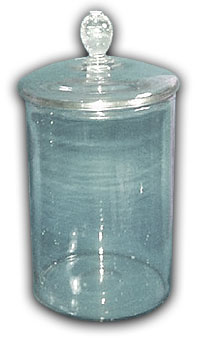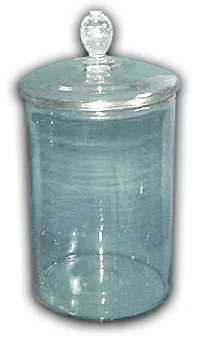The concept of a glass medicine bottle is nothing new. For nearly two millennia, glass bottles have been used to hold medicines and perfumes. The earliest ones were the Roman unguentaria, sometimes called “teardrop bottles.”
During their heyday American apothecary bottles stored everything from drugs and perfumes to spices and poisons — and lined the shelves of nearly every drugstore.
Most of the bottles were by made by glass companies in Pittsburgh, West Virginia, and Ohio, where coal — an important glass ingredient — was abundant. The plain, cylindrical jars generally had paper labels and heavy covers that were set into the mouth, like stoppers.
Most apothecary jars are valued at more than $500, because they’re rarely found in good condition. These bottles were utilitarian things, they were knocked around, and they took a beating.
Apothecary bottles are a type of glass or ceramic containers traditionally used by apothecaries, pharmacists, and herbalists to store and dispense various medicinal substances, herbs, tinctures, and other pharmaceutical products.
They are characterized by their distinctive vintage or antique appearance and often come in a variety of shapes and sizes. Apothecary bottles typically have specific features that make them suitable for their intended use:
Apothecary bottles are typically made of glass or ceramic materials, which help preserve the purity and quality of the substances stored inside. Amber glass is commonly used to protect the contents from light exposure.
These bottles often have labels on the front, describing the contents and dosages. They may also have unique, decorative stoppers or caps to seal the bottle securely.
Apothecary bottles come in various shapes, including round, square, or hexagonal, and a range of sizes to accommodate different quantities of substances.
Many apothecary bottles are designed to have a vintage or antique aesthetic, which adds to their charm and historical appeal.
Apothecary bottles are now often used for decorative purposes, such as in interior design or as collectors’ items, as they evoke a sense of nostalgia and history. They are also sometimes used for storing and presenting homemade herbal remedies, essential oils, or other liquids.
While the traditional role of apothecaries has evolved, these bottles continue to be associated with the history of pharmaceutical and herbal medicine.
Here are some cleaning no-no’s and an interesting example of these specialized bottles:
How should apothecary bottles be cleaned?
Most collectors have a sense of what to do — simply use a cool damp cloth. Don’t put the bottles in the dishwasher, because it can expose lead in the glass. And don’t immerse them in water, because you’ll ruin the paper label. Some bottles also have a painted tin top that can corrode. But most collectors, both experienced and new collectors, know that you don’t want to use steel wool or anything abrasive.
Have you seen any interesting ones lately?
Last winter one sold that was a soft green color with lots of bubbles. It was one of the more elaborate ones seen — 3-tiered and it had applied glass feet. It was very unusual. One piece fit into the next, with a large bottle, with a second one that fit into it, and a third that fit into the second.


Bud Hastin’s Avon Collector’s Encyclopedia : The Official Guide for Avon Bottle and Cpc Collectors by Bud Hastin
Home Apothecary : Growing & Using Traditional Remedies by Jessica Houdret, Michelle Garrett
Bruising Apothecary : Images of Pharmacy and Medicine in Caricature by Kate Arnold-Forester, Nigel Tallis
Absinthe: History in a Bottle by Barnaby Conrad
Bottles and Bottle Collecting by AAC Hedges, Alfred Alexander Charl Hedges
Commemorative Bottle Checklist & Cross-Reference Guide – featuring Coca-Cola Bottles by Richard Mix
Kovels’ Bottles Price List, 11th Ed by Ralph Kovel, Terry Kovel
Absolut: Biography of a Bottle by Carl Hamilton
Bottle Pricing Guide by Hugh Cleveland
Corkscrews and Bottle Openers by Evan Perry
The Beauty to Perfume : Perfume Bottle Auction VI by Randall Monsen
The Legacies of Perfume : Perfume Bottle Auction VII by Randy Monsen
Related stories
Are Salt and Pepper Shakers collectible What to look for
What to look for when collecting Egg Cups
What to collect in Vintage & Antique Cruet Sets





